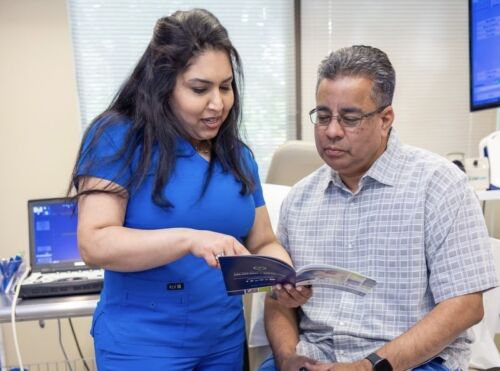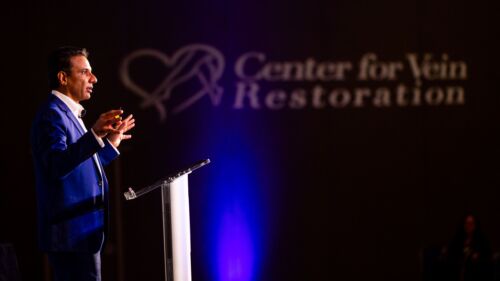Poor circulation in your hands and feet point to poor circulation. The good news is that you can treat it.
Your blood moves through your body with the help of arteries and veins. The arteries bring blood filled with oxygen and nutrients to your tissues and organs. The depleted blood then returns to the heart via the veins for another oxygen boost. When your circulation works efficiently, you will give it little thought. But if blood flow is slowed or blocked for any reason, you’ll feel the symptoms of poor circulation, starting with your hands and feet.
Fortunately, you can improve circulation in your hands and feet with a combination of medical and conservative treatments. But before treatment, you’ll need to address the condition's underlying cause. Let’s review the reasons and how poor circulation is best treated.
What causes poor circulation in the hands and feet?
A range of symptoms can indicate poor circulation in the hands and feet. Swelling, pain and cramping in the legs and feet are common symptoms of venous insufficiency, which stems from a lack of blood flow in the extremities. Varicose veins are another common symptom of chronic venous insufficiency (also known as CVI).
When plaque narrows the arteries in the legs, you’ll feel pain, numbness, and tingling in the legs. These signs signal peripheral artery disease (PAD). RWJ Barnabas Health estimates between 12 percent to 20 percent of people aged 60 or older have PAD.
Raynaud’s disease, a condition that pinches the blood vessels in the hands and fingers, is also attributed to circulatory problems. The most prominent symptoms of Raynaud’s disease are cold hands and fingers, especially in cold temperatures. Cold feet and hands, as well as numbness in the extremities, can be caused by diabetes, a disease that damages the blood vessels and nerves. High blood pressure is a significant factor in poor circulation, too.
8 treatments for poor circulation in the hands and feet
To diagnose poor circulation, your doctor will review your symptoms and conduct imaging tests, such as an ultrasound, to obtain a picture of your blood flow. Your doctor may order blood tests to detect high blood sugar or inflammatory diseases, including Raynaud’s disease.
Once your doctor determines the underlying cause, treatment will focus on managing that condition to reduce symptoms and prevent them from worsening. Therapies can include self-care remedies, minimally invasive surgeries, or medication. Your doctor may also recommend a combination of all three. Here are eight of the best treatments for poor circulation in your hands and feet:
Exercise more. Your veins and arteries do a great job circulating blood, but they can’t do it alone. Exercises such as walking, swimming, and biking, support the veins as they pump blood.
Do hand exercises. To improve circulation in the hands and fingers, you can extend your hand in front of you and shake for a few seconds. Or, try clenching your fist with a stress ball in your hand.
Change your diet. A diet high in fats and sodium can contribute to plaque buildup in the arteries and water retention, which restricts circulation in the veins. Instead, eat flavonoid-packed foods such as bell peppers, onions, broccoli, cherries, and apples, as flavonoids strengthen vein walls. The omega-3 fatty acids found in fish can also improve cardiovascular health. A healthy diet combined with exercise can help you shed pounds, too. The fewer pounds you carry, the less strain you’ll put on your veins.
Elevate your legs. Raising your legs above your heart can drain the blood from your legs back to your heart. As the blood flows upward, your symptoms will diminish. You can also practice yoga poses that put your legs up.
Wear compression stockings. Tightly woven compression stockings apply gentle pressure on the leg veins to promote blood flow. If you sit or stand all day, wearing compression stockings can keep the circulation moving so blood doesn’t pool in the veins.
Take your medication. Medications such as alpha-blockers and calcium channel blockers have successfully treated Raynaud’s disease. If you’ve been prescribed medication for high blood pressure or diabetes, take it as directed.
Quit smoking. The harmful chemicals in tobacco can lead to a buildup of plaque in the arteries, which restricts blood flow. Talk to your doctor about programs to help you quit smoking.
Explore surgical options. Exercising, losing weight, and taking medications provide symptom relief. But if poor circulation results from venous insufficiency or varicose veins, you can explore minimally invasive treatment options offered by a vein specialist. These office-based procedures take about an hour to complete and can destroy the diseased vein, thus restoring healthy circulation.
Poor hand and foot circulation is not just a collection of bothersome symptoms. It’s a severe vascular disorder that requires treatment. If left untreated, it can lead to dangerous blood clots, skin ulcers, and cardiovascular disease. See a qualified vein doctor, such as the board-certified specialists at Center for Vein Restoration (CVR), as soon as you notice the first symptoms of poor circulation. CVR can address the issue before it worsens.
Your vascular specialists in Massachusetts
CVR operates a full-service vein care center in Framingham, Massachusetts, led by Pamela Kim, MD, RPVI, a board-certified vascular surgeon with additional certification in General Surgery and Vascular Interpretation. With a full range of treatment options available for varicose veins and other vascular disorders, Dr. Kim will improve your circulation, so you no longer need to live with the pain and swelling of poor circulation.
Don't live near our Framingham CVR vein clinic location? No problem! With over 100 vein clinic locations in 22 states and the District of Columbia, there's sure to be a CVR vein center near you.
Contact Dr. Kim to learn more about your treatment options, or schedule your consultation appointment online today!

 About Vein Disease
About Vein Disease
 Spider Veins
Spider Veins
 Varicose Veins
Varicose Veins
 Vein Disease Treatments
Vein Disease Treatments
 Treating Spider Veins
Treating Spider Veins
 Treating Varicose Veins
Treating Varicose Veins
 About Us
About Us
 Patient Resources
Patient Resources
 Physician Resources
Physician Resources


